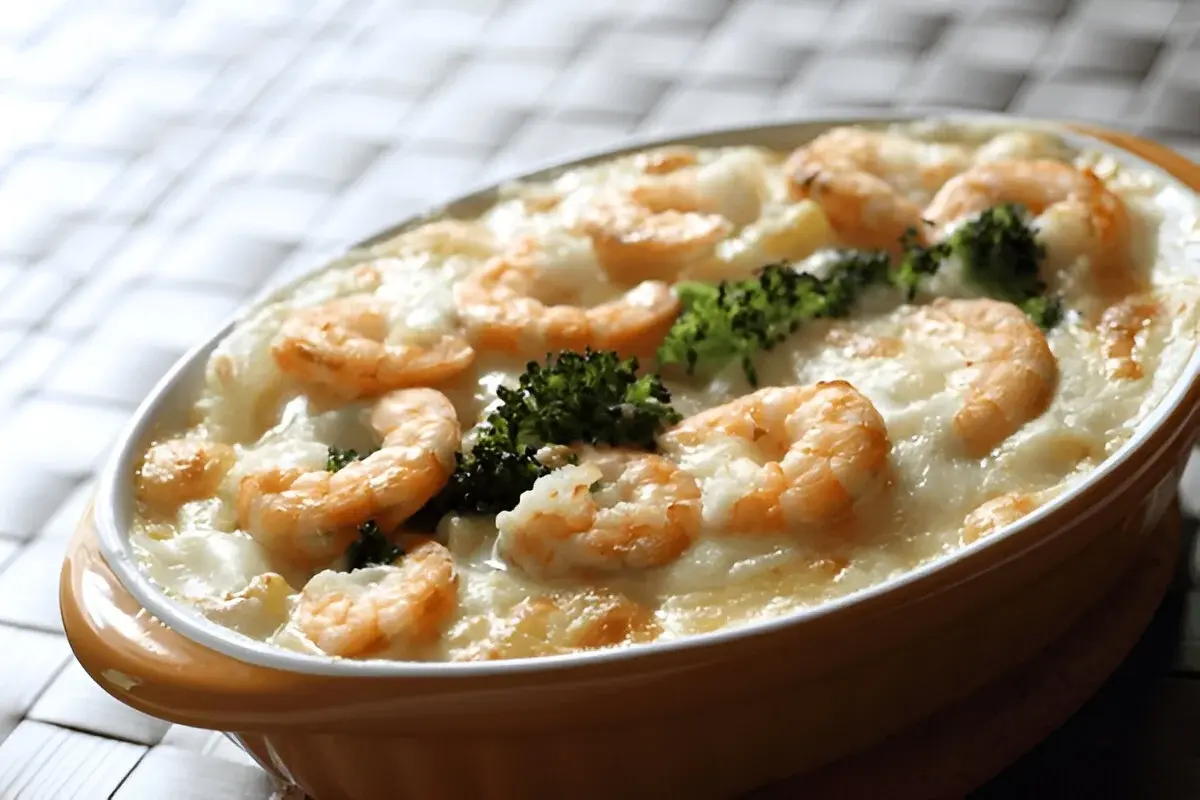Imagine shrimp paired with a creamy, cheesy topping – that’s the magic of shrimp au gratin. This article explores this classic comfort dish, from selecting the best shrimp to perfecting the creamy sauce. Ready to dive in? Let’s get started!
Understanding the Allure of Shrimp au Gratin
What Exactly is Shrimp au Gratin?
At its heart, shrimp au gratin is a classic baked dish that’s all about comfort and indulgence. It features tender shrimp enveloped in a luscious, cheesy sauce, typically enriched with cream or milk and often topped with breadcrumbs or extra cheese for a beautiful, golden crust. Indeed, the “au gratin” part refers to that lovely browned topping, which provides a fantastic textural contrast to the creamy interior. It’s a dish that’s both simple enough for a weeknight meal and elegant enough for a special occasion.
Why is Shrimp Au Gratin so popular?
Shrimp au gratin is popular for several reasons. The creamy, cheesy shrimp provides warmth and comfort, while its versatility shines through—whether as an appetizer, main dish, or side. Its rich flavor and adaptability make it a great choice for any meal, whether quick or special.
Key Ingredients for the Perfect Shrimp au Gratin
Selecting the Best Shrimp for au Gratin
The quality of shrimp is key to a great shrimp au gratin. Whether you choose fresh or frozen, both can work well—just ensure the frozen shrimp is properly thawed. Medium-sized shrimp are ideal as they cook evenly and fit nicely in the dish, though larger shrimp can also be used with adjusted cooking times. Ultimately, the best shrimp for this dish is simply high-quality shrimp that you enjoy.
The Cheesy Sauce Core: Cheese Types and Cream
The cheesy sauce is the heart of shrimp au gratin. Cheddar cheese is a great all-around choice for its sharp flavor and meltability. To elevate the dish, try Gruyere cheese for its nutty, slightly salty notes, or Parmesan for a salty, umami punch. For the base, use high-quality cream and milk—heavy cream creates a richer sauce, while a mix of milk and cream offers a lighter option. The key is using top-notch dairy, as it greatly impacts the final result.
Adding Flavor Boosters to your au Gratin
Now, while cheese and cream are certainly amazing on their own, they benefit greatly from some flavor boosters! Aromatics, such as garlic, onions, or shallots, form an essential flavor foundation, as they help build a more complex taste profile. Furthermore, feel free to add some fresh or dried herbs and spices for an extra layer of flavor. For instance, a dash of paprika can bring warmth, or a pinch of thyme will lend a beautiful earthiness. Ultimately, this allows you to customize your shrimp au gratin to your liking.
Step-by-Step Guide: How to Make Shrimp au Gratin
Preparing the Shrimp and Other Ingredients
Before you start cooking, it’s important to prepare all of your ingredients. First, clean the shrimp carefully, removing any shells or veins. Then, ensure they are patted dry for the best results. Additionally, finely chop all of your aromatics (garlic, onions, shallots), and grate your cheese, so they’re ready when you need them. This will also make the entire cooking process much smoother and less stressful.
Creating the Creamy Cheese Sauce
The creamy cheese sauce, or béchamel, may seem tricky, but it’s actually quite straightforward! First, melt some butter in a saucepan, then whisk in flour to create a roux. Gradually add in your milk or cream, whisking constantly to avoid lumps. Once the sauce thickens, stir in your cheese until it melts into a smooth, velvety sauce. Indeed, this is where all that cheesiness starts to come together, making that mouth-watering shrimp au gratin.
Assembling and Baking the Shrimp au Gratin
Now that your sauce and shrimp are prepared, it’s time to assemble the dish. Start by layering the shrimp in a baking dish, then pour the cheese sauce over the shrimp, ensuring everything is covered. To get that gorgeous golden crust, you can add a sprinkle of breadcrumbs or more cheese on top. Now, bake in a preheated oven until the top is golden brown and bubbly, and the sauce is bubbling all around the sides. The baking time can vary, so keep an eye on it! Once ready, let it rest for a few minutes before diving in. And there you have it, your home-made shrimp au gratin!
Variations and Twists on Classic Shrimp au Gratin
Elevating the au Gratin with Gourmet Ingredients
While classic shrimp au gratin is delicious, there’s always room for creativity! Try adding sautéed mushrooms, wilted spinach, or artichoke hearts for unique textures and flavors that complement the shrimp and cheese sauce. You could also experiment with cheeses, like smoked Gouda for depth or Fontina for a nutty touch. A drizzle of truffle oil can elevate the dish even further! The possibilities are endless, making shrimp au gratin a versatile base for your culinary creativity. For a truly special occasion, you might even consider using lobster instead of shrimp, and for a great recipe to cook lobster, consider our Lobster Tail Recipe.
Spicy Shrimp au Gratin: Adding Heat
If you love a little kick, then a spicy version of shrimp au gratin is something you have to try! You can easily infuse some heat by adding a pinch of red pepper flakes to the cheese sauce, or a dash of your favorite hot sauce. Furthermore, a small amount of cayenne pepper can work wonders for adding just the right amount of fire. Indeed, a touch of spice really wakes up the dish and offers a pleasant contrast to the richness of the cheese. So, don’t be shy and experiment with the spice level until you find your perfect balance!
Lower-Carb Shrimp au Gratin Alternatives
For those looking to reduce carbs, you can still enjoy the flavors of shrimp au gratin without feeling guilty. Instead of breadcrumbs, consider using grated cauliflower or even sliced zucchini as the base. Indeed, these alternatives are low in carbs and still provide a lovely texture. These substitutions allow you to enjoy all the cheesy goodness without the extra carbs, which is certainly a great thing!
Serving Suggestions and Pairings for Shrimp Au Gratin
What to Serve with Your Cheesy Shrimp au Gratin
Shrimp au gratin can be a meal on its own, but it also shines when paired with the right side dishes. For example, a simple crusty bread or baguette would be perfect for scooping up every last bit of that amazing cheese sauce. Additionally, a light and fresh salad can cut through the richness of the dish and provide a welcome contrast. Similarly, rice or quinoa can be a great choice to make the meal more substantial. If you’re in the mood for something flavorful and savory, consider adding Honey Garlic Chicken to balance out the richness of the shrimp au gratin.
Beverage Pairing Ideas
Choosing the right drink can really elevate your shrimp au gratin experience. For wine lovers, a crisp, dry white wine like Chardonnay or Pinot Grigio often works wonders, complementing the richness of the cheese and seafood. Beer drinkers might enjoy a light, refreshing lager or a wheat beer. If you prefer non-alcoholic options, sparkling water with a squeeze of lemon or lime would be a great, refreshing choice. For a hearty, cozy pairing, try Marry Me Chicken Soup, which adds a comforting touch to any meal.
Tips and Tricks for the Best Shrimp au Gratin
Preventing Common Mistakes
Making shrimp au gratin is quite straightforward, yet there are a few common mistakes to watch out for. First off, be careful not to curdle the sauce. To prevent this, make sure to use a low heat when making the béchamel base, and whisk constantly. Also, avoid overcooking the shrimp, as they can become tough and rubbery. They’re typically cooked to perfection when they turn pink and opaque. Moreover, be mindful of the baking time – the dish should be golden brown, not burnt. Indeed, paying attention to these little details can make all the difference between a good shrimp au gratin and a great one!
Making Shrimp au Gratin Ahead of Time
Shrimp au gratin is perfect for entertaining and can be prepped ahead. Assemble the dish, cover, and refrigerate. When ready to serve, bake as directed. Crock Pot Beef and Noodles It can be prepped earlier and enjoyed alongside your shrimp au gratin. When reheating, do so gently to prevent the sauce from separating. Add extra milk or cream to restore the creamy consistency if needed. This lets you prepare ahead and spend more time with your guests.
Nutritional Content (per 100g)
Please note: The following nutritional information is an estimate and can vary based on specific ingredients and portions used in a shrimp au gratin recipe.
| Nutrient | Amount (per 100g) |
|---|---|
| Calories | Approx. 200-250 |
| Total Fat | Approx. 12-18g |
| Saturated Fat | Approx. 7-11g |
| Cholesterol | Approx. 100-150mg |
| Sodium | Approx. 300-400mg |
| Total Carbohydrates | Approx. 8-12g |
| Dietary Fiber | Approx. 1-2g |
| Sugars | Approx. 2-4g |
| Protein | Approx. 15-20g |
FAQs
What is an au gratin dish?
“Au gratin” refers to a cooking technique where a dish is topped with breadcrumbs or grated cheese and then baked or broiled until it forms a golden-brown crust. Consequently, this method provides a wonderful contrast in texture, making each bite enjoyable.
What does cooked au gratin mean?
When something is cooked “au gratin,” it means that it has been prepared in this manner, typically by baking. The key is the topping, which is usually cheese and/or breadcrumbs, and which gets nicely browned and crispy. Indeed, that crispy, golden topping makes a huge difference to the final taste!
Which is better scalloped or au gratin?
While both scalloped and au gratin dishes often involve creamy sauces and baking, they are quite different. Scalloped dishes usually have layers of thinly sliced potatoes or other vegetables, whereas au gratin emphasizes the browned, crispy topping. Ultimately, which one is “better” simply depends on personal taste and the desired result!
Why is it called au gratin?
The term “au gratin” comes from the French word “gratter,” which means “to scrape” or “to grate.” Therefore, this refers to the breadcrumbs or cheese that are scraped across the top of a dish before baking. This method results in the characteristic browned crust that is so essential to this preparation.

